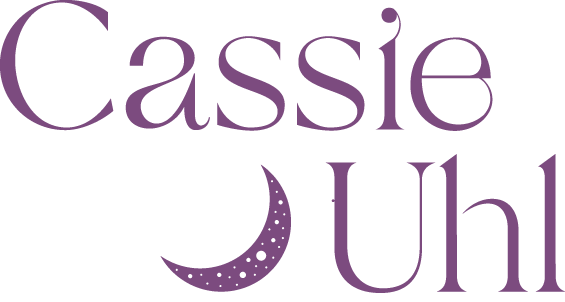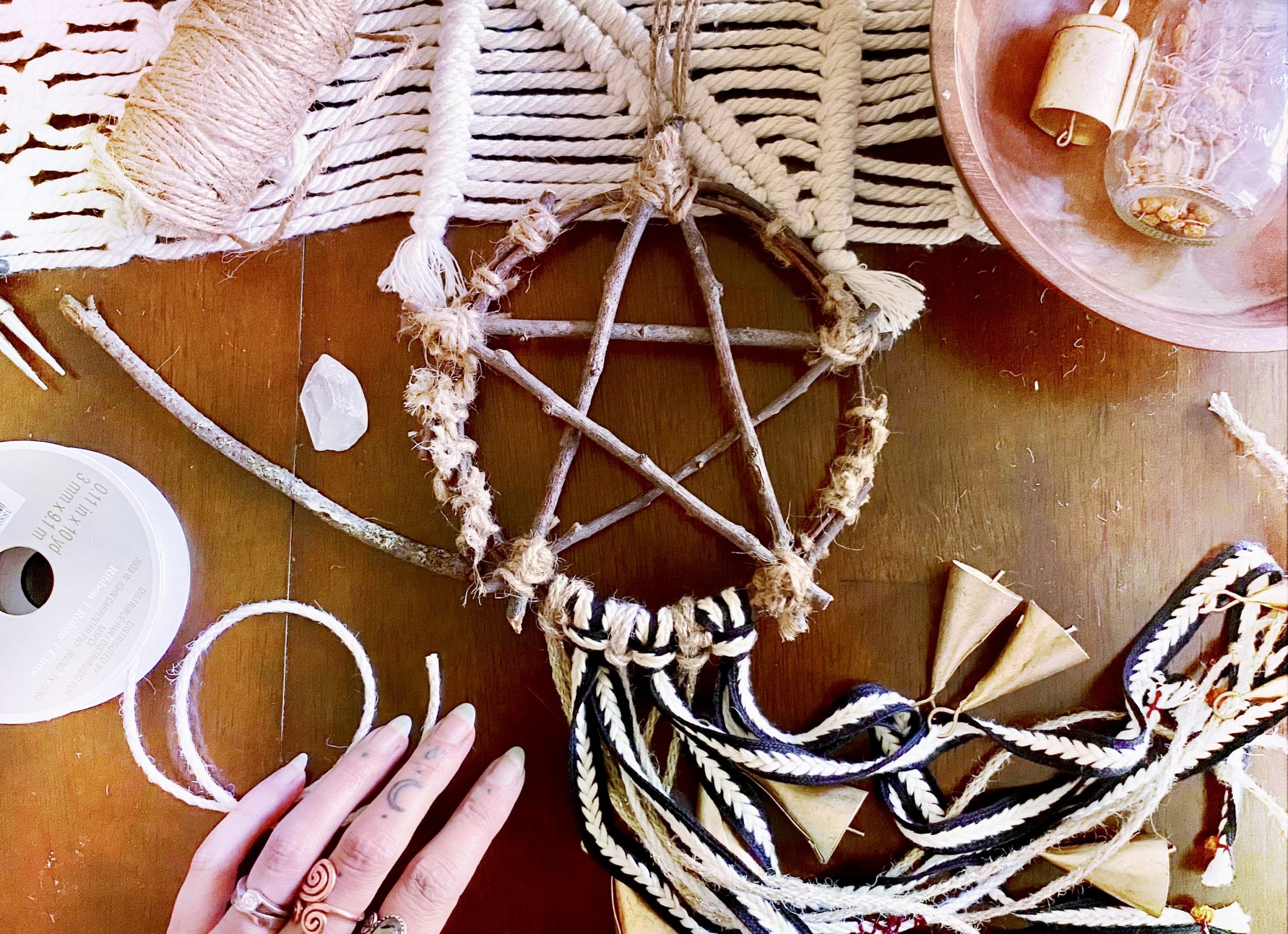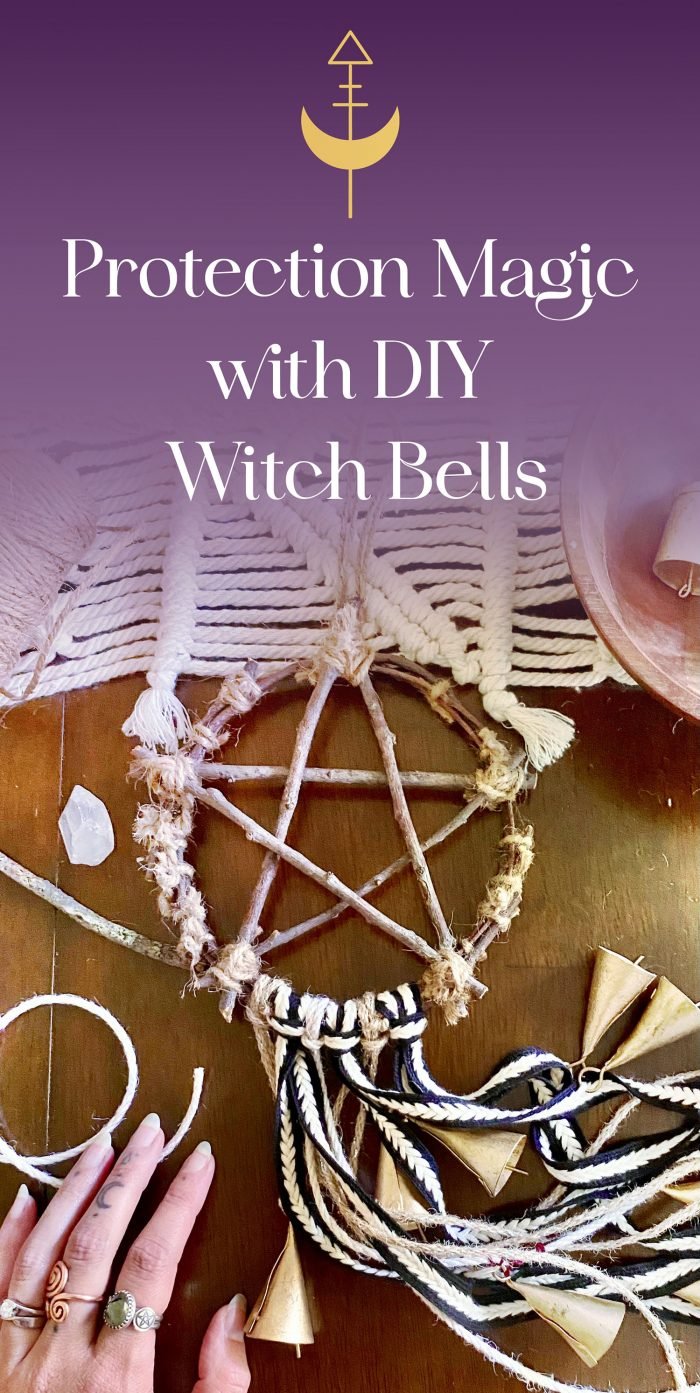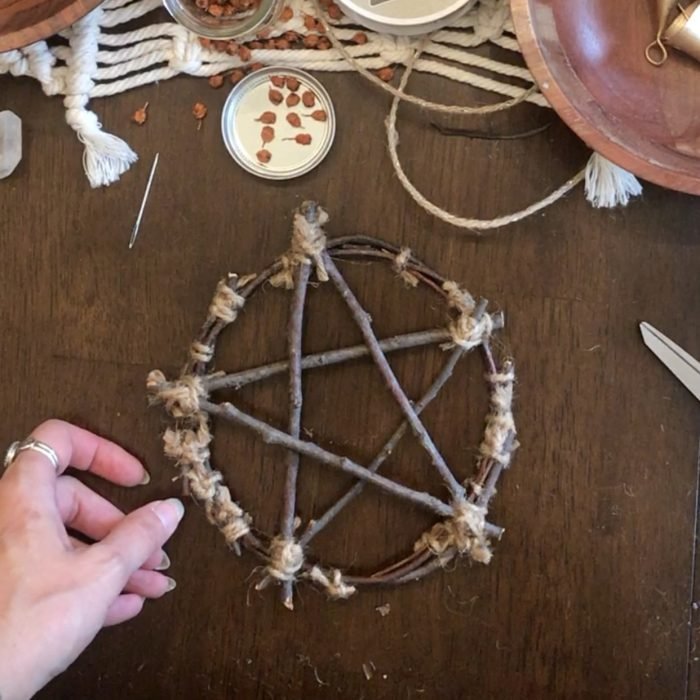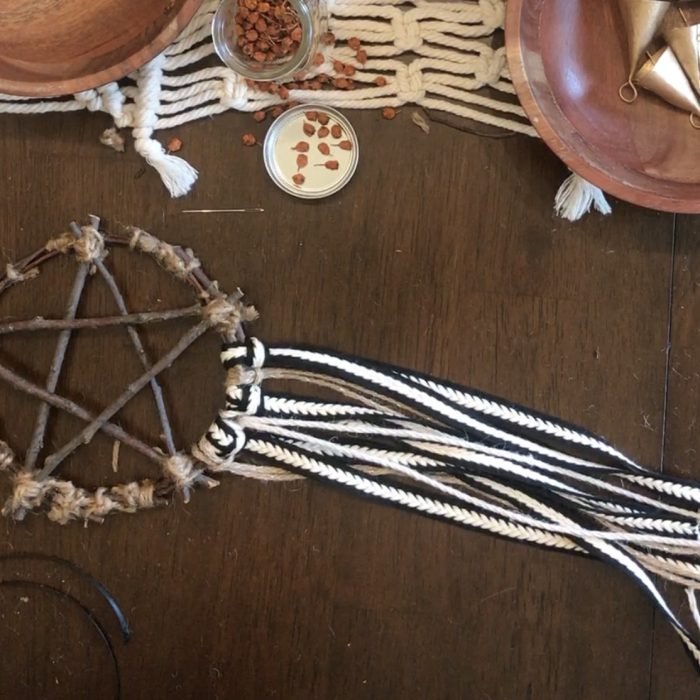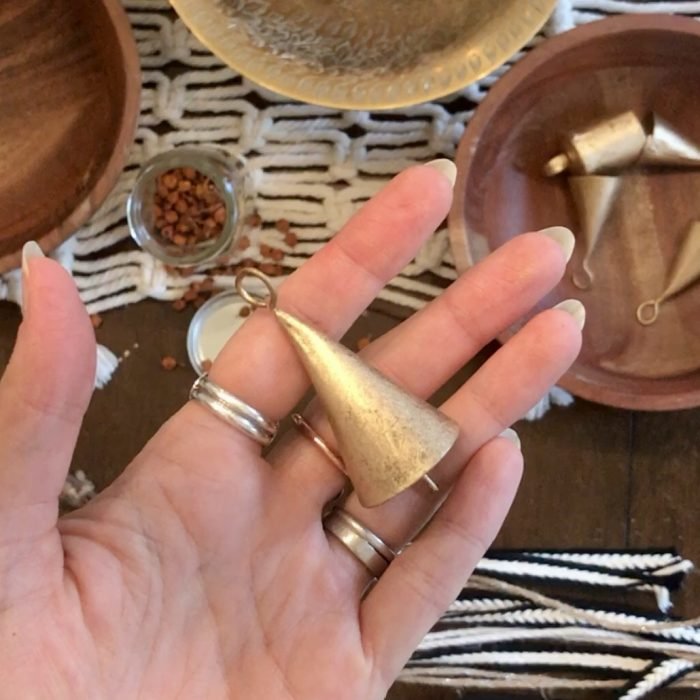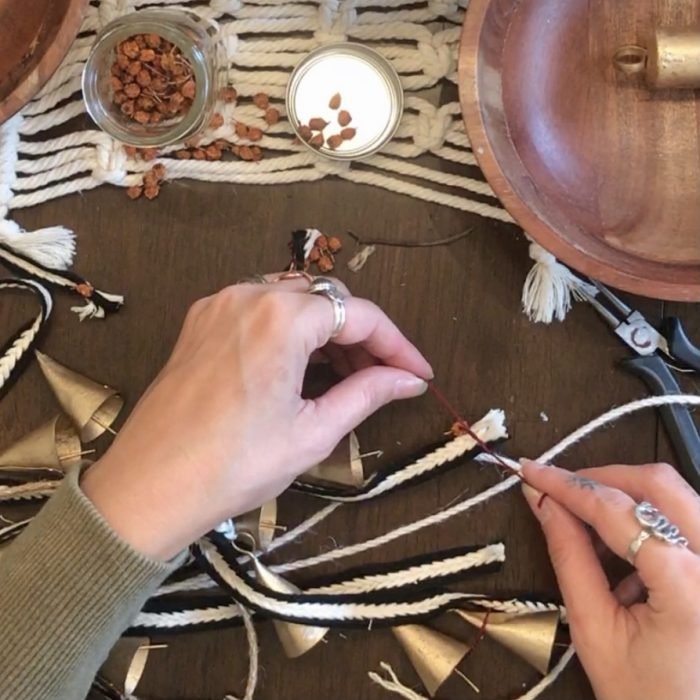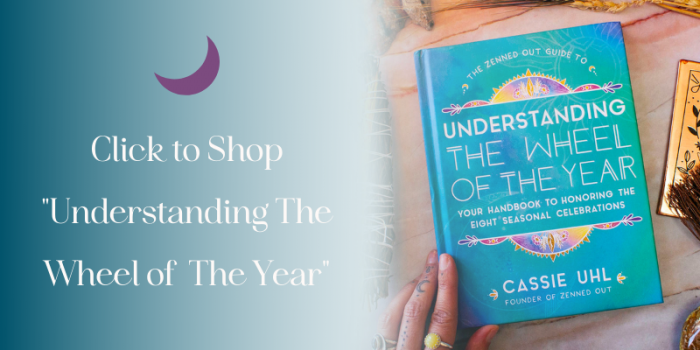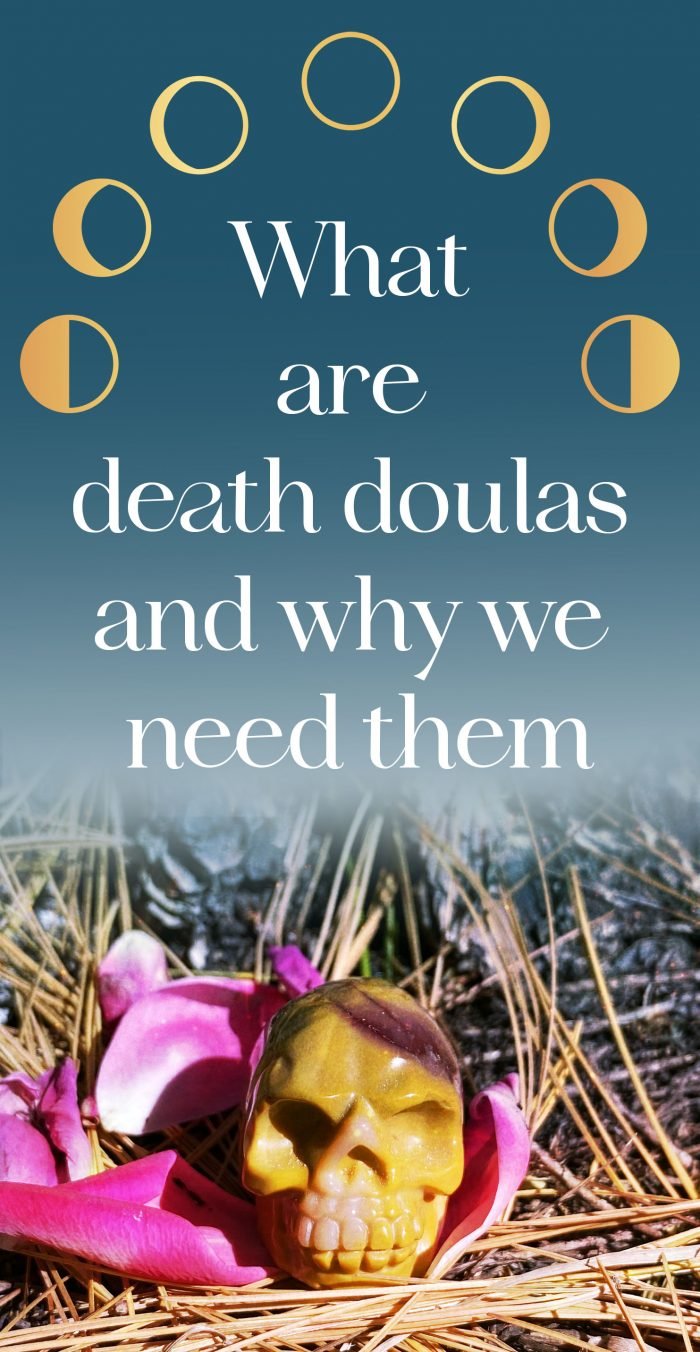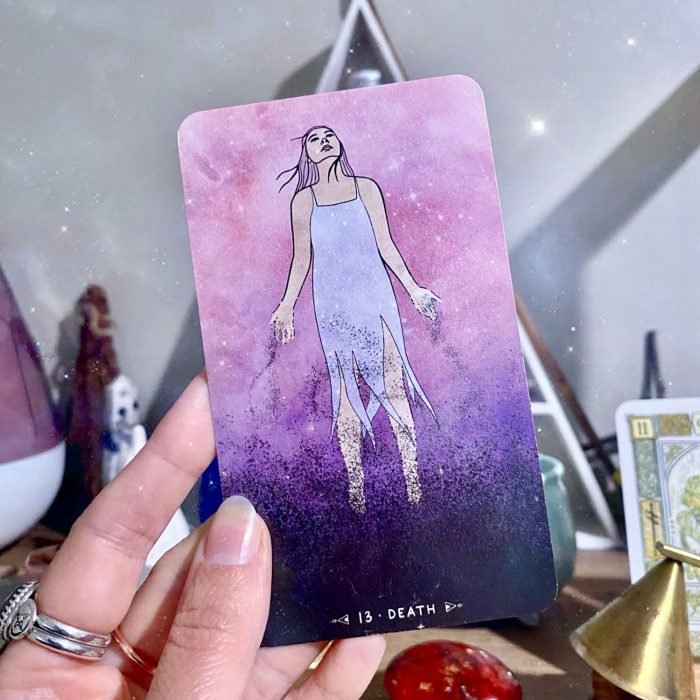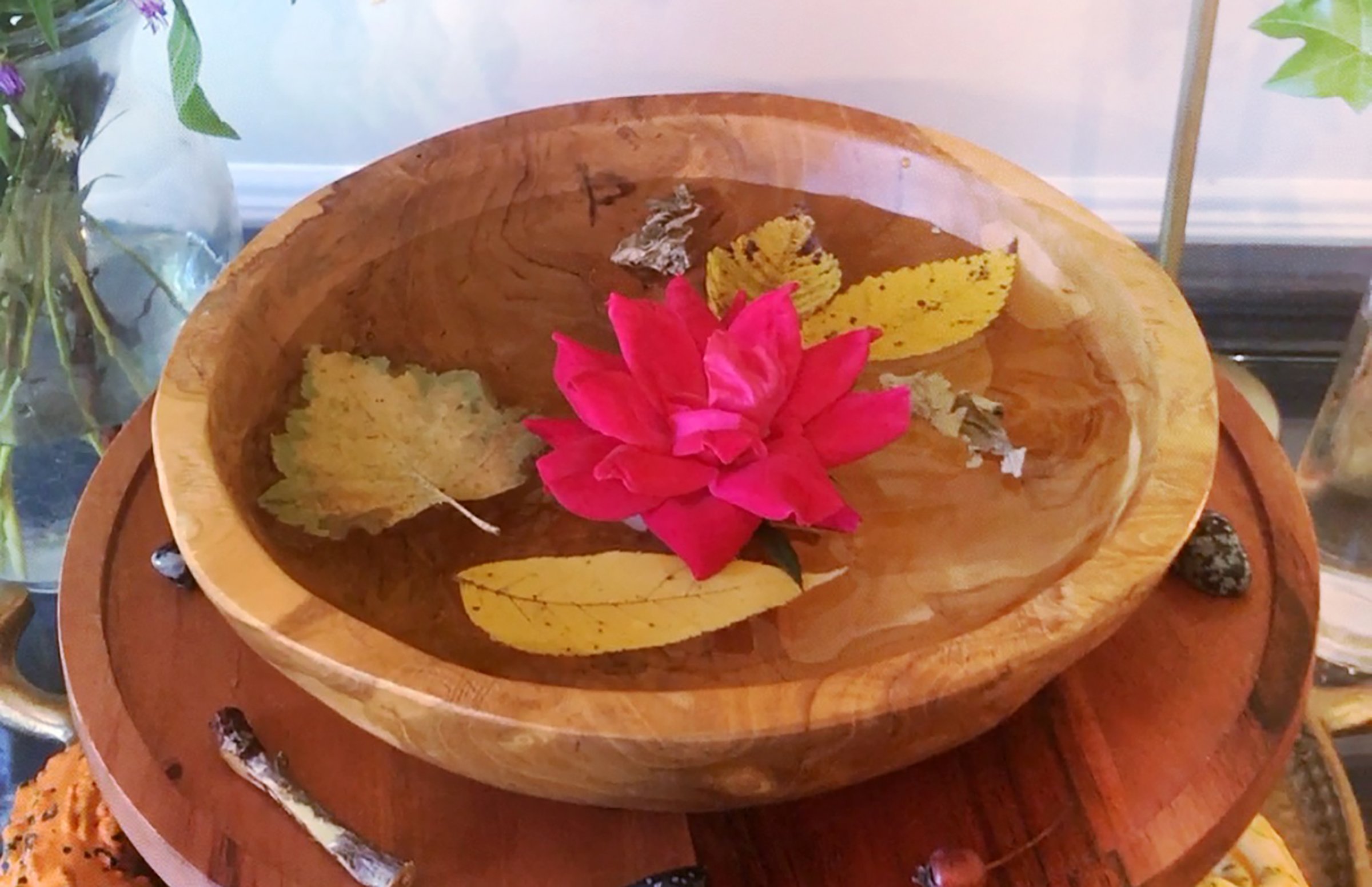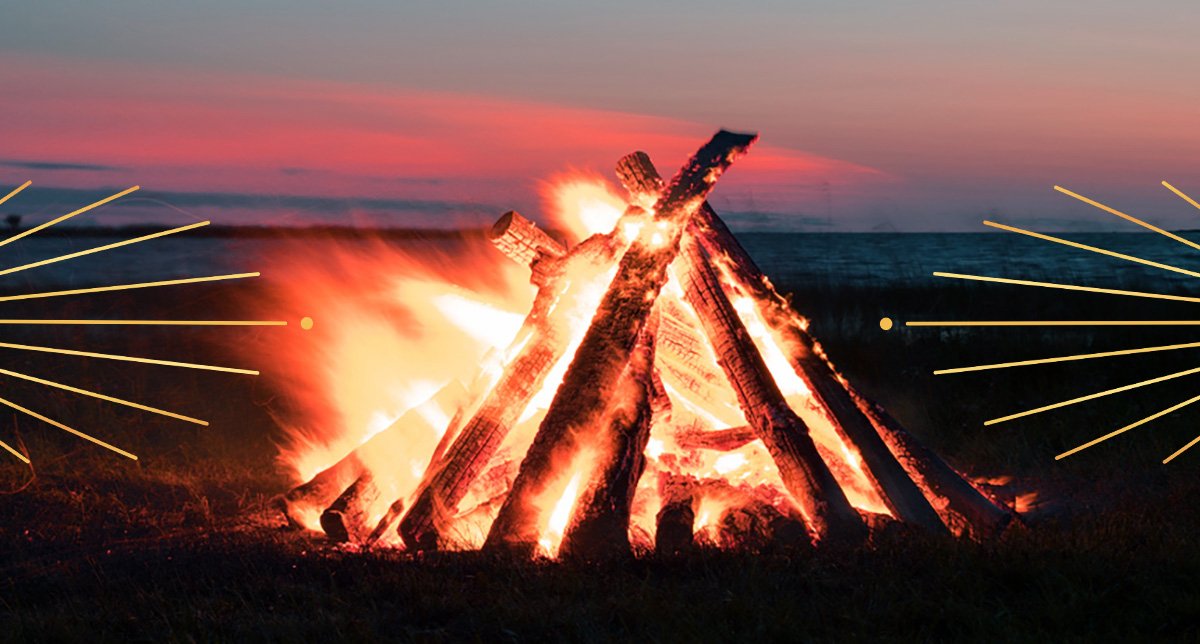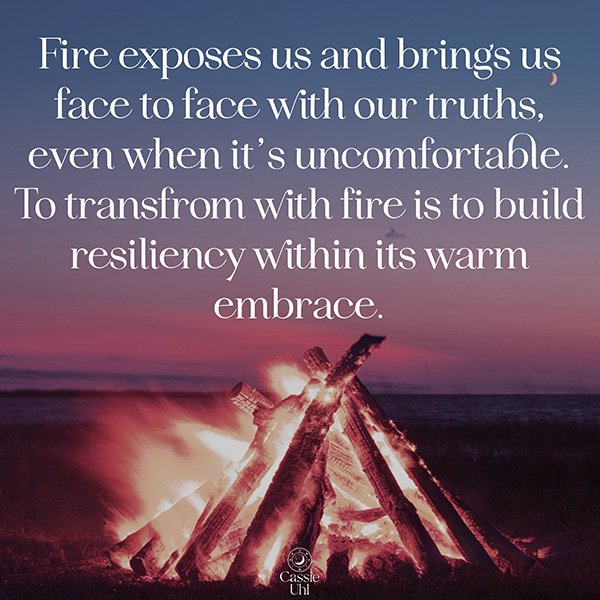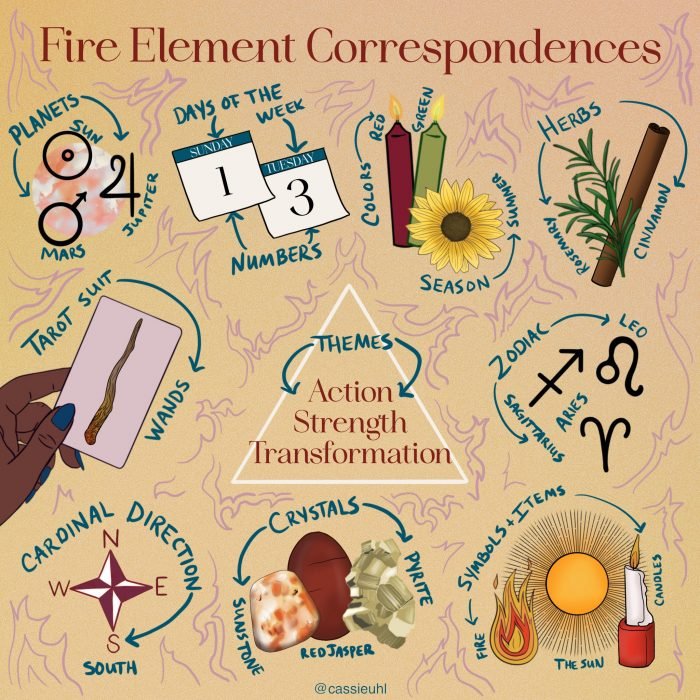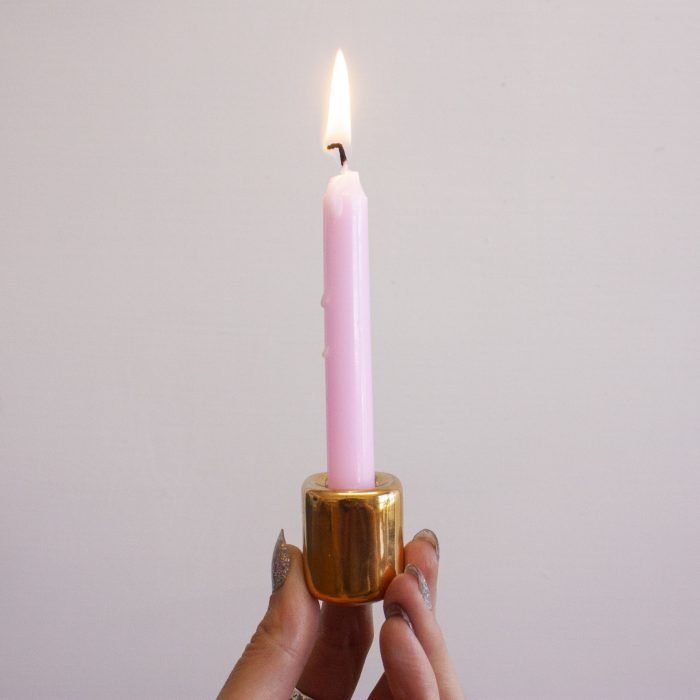Protection Magic with DIY Witch Bells
There are so many ways to celebrate the season of Samhain, and protection magic is a common theme. With the veil between the spirit and physical realm at its thinnest, it offers us a time to connect with loved ones in spirit, but it can also give rise to unwanted energies and spirits. Taking time to bring in additional energetic protection for yourself and your home is an easy way to address this and honor the season.
There are so many ways to celebrate the season of Samhain, and protection magic is a common theme. With the veil between the spirit and physical realm at its thinnest, it offers us a time to connect with loved ones in spirit, but it can also give rise to unwanted energies and spirits. Taking time to bring in additional energetic protection for yourself and your home is an easy way to address this and honor the season.
I love to do a full house cleansing and blessing for Samhain, which you can learn more about in this past post. After performing a house cleansing and blessings is a great time to introduce additional protection magic like witch bells.
Bells have been and still are used by many cultures for various spiritual practices, and they’re a standard tool for most witches and folk magic practitioners. Bells are a common cleansing tool, and the loud sound is said to scare off malevolent spirits.
My favorite thing about witch bells is that you can be so creative with them and customize them, both in appearance and in intention, in so many ways. I’m going to share general steps to craft your witch bells so that you can create protective witch bells that work for you and your space. Here are some general considerations for all magic making.
The efficacy of your spellwork and magic will consistently increase when you co-create with items with which you have an established relationship. If you’re wondering how to have a relationship with a tree or a stone, here are some simple options.
Meditate to connect with the energy of the plant or item.
Spend more time with the plant or object.
Give offerings to the plant or item.
Always ask permission before taking things from a living plant or tree.
You don’t need to use the same items I use for my witch bells. I encourage you to use items unique to your environment and needs. If there are plants, stones, or things that represent safety, protection, and clearing to you, that is great. Use those.
DIY Witch Bells
You’ll need the following:
30-90 minutes
String, yarn, or ribbon of choice
5-10 bells
Optional: incense or herbs to energetically cleanse your items
Optional: Something to hang your bells from, like a wooden circle, a pentacle, or something else that fits your needs.
Optional: Any additional items (crystals, beads, stones, plant items, etc.) that correspond with your intention.
Watch the steps in action here.
Steps:
1. Take some time to plan your specific intentions for your witch bells and prepare all of your items. Consider energetically cleansing your items before you begin with smoke, incense, or something else in your practice.
2. If you’re crafting something to hang your string from, do that now. I used fallen apple tree twigs to make a circle and a pentacle. This was the most time-consuming part for me! I am pleased with how it turned out, but wood circles or mini wreaths can be purchased at most craft stores if you want to go an easier route. You can also opt to make a loop out of your string and skip the circle.
3. It’s time to attach your strings or ribbons. I made simple loops to secure mine, but you could also tie them onto your circle. As you begin knotting and tying, it’s an excellent time to start focusing on your intention for your bells. You could visualize an auric energy field growing around your house, offering greater protection and peace. You could also envision inviting any healed and well ancestors into your home and blocking any who are not.
Tip: Consider your color choice for your string and ribbon. Each color carries a different energy. I used black and a deep red for grounding and protection.
4. Now, you can attach your bells. Use any bells you prefer. You may need to tie them on or use pliers. Add as many as you like, and keep your intentions in your mind. You could even repeat a chant to increase the energy.
5. If you’ve opted to add extra items like stones, beads, or plant items, do that now. I tied Rowan tree berries and Hawthorne tree thorns into my ribbon and strings for additional protection and grounding.
6. When your witch bells feel complete, hold them in your hand, focus on your intention, and consider reciting a particular phrase like, “Protect and bless this house, so it is,” or anything else that feels good to you.
7. You’re all done! Hang your bells on your front door knob. Consider charging it under full moons or giving it a good energetic cleanse every once in a while to keep them happy.
Wishing you a magical Samhain! Check out more posts about Samhain here.
What are Death Doulas and Why we Need Them
It's time to call in our demons around death and dying. They need healing and nourishment. As we continue to walk through a world steeped in an ebb and flow of grief and death, we have an opportunity to address our relationship with death and dying. Not only do we need to address these wounds to better equip us to care for our dying, but I believe there's also a well of healing to be found within nourishing our wounds around death. Addressing our relationship to death and dying is one way to do this. Addressing how we care for the dying is another way to do this.
It's time to call in our demons around death and dying. They need healing and nourishment. As we continue to walk through a world steeped in an ebb and flow of grief and death, we have an opportunity to address our relationship with death and dying. Not only do we need to address these wounds to better equip us to care for our dying, but I believe there's also a well of healing to be found within nourishing our wounds around death. Addressing our relationship to death and dying is one way to do this. Addressing how we care for the dying is another way to do this.
In this share, I'll offer some personal thoughts on why so many of us have a difficult relationship with death, especially in the West, opportunities and ways to heal our connection with death and the benefits of doing so. You'll also learn what a death doula or end-of-life doula is and their role in the dying process.
Listen to this post on my podcast here.
If you think this doesn't seem like a very spiritual topic, that's precisely why I'm talking about it. We're all going to die, even you, and if our spiritual practices only encompass life, then we're missing a huge portion of wisdom by avoiding talking and thinking about death. If you have anxiety about your mortality, and the mere mention of discussing death stirs internal fear and anxiety, you are not alone. I encourage you to stick around. I, too, used to have intense fear and anxiety about dying.
I spent a large part of my adolescence and young adulthood holding onto an intense fear and anxiety around dying. It caused me sleepless nights and even altered my plans from time to time. The worst part was that I didn't feel like there was anyone I could talk to about these fears. I knew they were deeply irrational and therefore spent most of my time trying to block these feelings, making them even more debilitating.
It wasn't until I was faced with death through the loss of my beloved grandmother and father within two months of each other that my thoughts and feelings about death slowly began to shift and change. I witnessed firsthand how dysfunctional our relationship with death is as I watched much of my family spiral into chaos with little support. Within the depths of my grief, something in me was cracked open. The tears from my sadness slowly eroded away my long-held fears about dying. The deep grief I experienced from these losses opened a pathway for healing my relationship with death and dying, and it also showed me the need for better death care.
This theme is reflected in the wise quote by Rumi, "The wound is the place where the light enters you." The wounds we face at different points in life can have the potential to grow and heal parts of ourselves when we have the time and space to do so. Of course, it also needs to be noted that having the time and space to heal our wounds when they arise is a privilege in and of itself and one that not all have access to.
The healing I experienced around death was not immediate. It slowly unraveled as I rode the waves of grief over several years, leaned into therapy, and explored death through my spiritual practice. My healing around death is still ongoing today. Like all healing, there's no finish line but a continuous spiral of growth and learning. Though I no longer experience the fear and anxiety of my inevitable death, I continue to find ways to challenge and heal my relationship with death and dying. Which, today looks like talking about death more and uprooting and untangling patriarchy and white and human supremacy from how I see and experience death. I've learned that the wise woman within me knows that death is a natural and even beautiful part of the cycle, not a failure as patriarchy would have us see it, which brings me to some thoughts on how we got here.
How did we get here, and why we need death doulas so badly right now?
In my personal experience with death and dying, combined with my spiritual practice and end-of-life doula training, I've realized that many of us carry a wound around death, and why wouldn't we? We rarely talk about it, our society, by and large, aims to remove death from sight, and many view it as a failure rather than a natural part of life. For example, phrases like "so and so lost their battle to cancer" imply that certain kinds of deaths are a failure instead of normal and natural parts of being human.
It goes much deeper than our simple avoidance of the topic. Wounds around death are yet another side effect of patriarchy, white supremacy, human supremacy, colonization, capitalism, and the suppression of earth-based, often Goddess-based, spiritual practices. Patriarchy and all of the supremacies live in a linear framework that always aims for more growth, creating a path that only leads up to more, more, more. Linearity leaves no room for death, individually or as a society. When our systems are set up to sidestep death and dying, it can feel challenging to embrace or even discuss death and dying because the systems in which we live do not allow space for it.
Our linear-focused society has been detrimental to ourselves, the planet, and all of its inhabitants. It reminds me of something I hear echoed by many of my anti-racism and decolonial teachers like Thérèse Cator and Dr. Rocio Rosalez Meza, which is the idea that due to white supremacy, white folks, especially, are cut off from our humanity. This couldn't be more clear than our relationship with death. Death is a natural part of being alive. Yet, our focus on supremacy and linearity strips us of our connection to death and its inherent wisdom. Though I don't think wounds around death are exclusive to white folks, I do think it's more prevalent. Our severed relationship with death and dying is yet another way we’ve been cut off from our humanity.
These ideas are a very condensed explanation of a much larger issue in which I am not an expert. In my study of anti-oppression work, death, and my spiritual practice, I've come to these conclusions. I encourage you to explore your ideas and learn from teachers who speak on the topic, especially those in the BIPOC community doing this kind of work.
Healing death wounds
So, where do we go from here? Here's a quote from one of my favorite books titled Mysteries of the Dark Moon by Demetra George, which is where I found the inspiration for the opening of this share, and I find she illustrates perfectly our need to heal our wounds around death.
"We must call our demons in from the backyard where they've been starved and banished into the leaking doghouse. We must welcome them in the warmth of our kitchens and feed them the foods that will heal their wounds of rejection. As we cleanse our inner images of the Dark Goddess through loving and accepting her, we will notice a corresponding decrease in the fear, anger, rejections, failure, disappointment, deceptions and hatred that we experience as part of our outer reality. In this way we reach the original true essence of the dark feminine that exists within us, an essence that is unclouded by layers of distortion."
Mysteries of the Dark Moon by Demetra George
I think this is a beautiful and powerful starting point. We must begin to call in death and invite death into our hearts and homes to heal our wounds around it. In doing so, we can become more whole. Furthermore, I find that addressing our relationship with death and dying in relation to where we are now as a collective is imperative and can give us the tools needed to remain grounded and useful in uncertain times. None of us are immune to the effects of climate collapse, and even if you've yet to be affected by it, it will affect all of us at some point, and grief and death will no doubt be a natural outcome.
Like our more than human plant and animal kin, death is an integral part of our cycle. It's easy to see the value of death in the natural cycles of plants and animals. Death is a needed part of the cycle that offers rest, decomposition, nourishment, and, eventually, rebirth. Though we've tried, we are not separate from this web, death will come for each of us, and it can have meaning too. Healing our relationship with death can have as much value for us today as the day we take our last breath. The sooner we each face our demons around death and dying, the more fully we can live in a world inundated with death.
This isn't to say that all deaths are fair and just. Absolutely not. The devastation we've already seen due to climate change disproportionately affects people of color and historically marginalized communities who have contributed the least to climate change. We should continue to fight against it. Changing our relationship with death can give us the tools to navigate these times and enable us to continue striving toward a more just and livable world rather than resulting to fight, flight, or freeze.
When we see ourselves as part of the web and cycles inherent in the earth, we can learn from the wisdom death has to offer. Healing our wounds around death can give us the resources and words we need so badly right now, resources like understanding living cyclically, being able to take ownership over our role in the current death cult of white supremacy, human supremacy, and patriarchy, the ability to be fully present with our human kin in their death phase, and understanding the need for contraction and death in our day to day lives and work. Healing our wounds around death gives us the language we need when we know we must step back from work, relationships, and the grind of living in a capitalist society.
We need to learn how to live in a world where excess death seems impossible to avoid. We must learn to be in a world that asks us to walk alongside death. And that is a big ask.
Death card from Journey Tarot by Cassie Uhl
Let's talk solutions and explore how death doulas can be one part of helping us heal our wounds around death and dying.
Death doulas, death midwives, and death walkers
An obvious place to begin healing our relationship with death is to offer better care to those dying. Anytime I bring up the term "death doula," people are immediately curious. This curiosity shows me how eager many are to have a better relationship with death. People are starting to see the benefits of discussing death more, planning for it, and offering more emotional and spiritual support for those at the end of life. Physical care from hospice and spiritual care offered by organized religion is no longer enough for most of us. In 2021 only 29% of people in the US identified as religious. We need more when it comes to facing our own deaths and the deaths of our loved ones.
I had the unique back-to-back experience of being with my grandmother during her death due to terminal cancer and my father's sudden and unexpected death due to a heart attack. I experienced firsthand how each kind of death, known and sudden, affected our family and me. While walking through these experiences, I learned a lot of things, but what stood out to me the most was the extreme lack of emotional and spiritual support for the dying and their loved ones. I also learned that death tends to bring out the worst in caregivers (likely due to lack of support) and that, due to my spiritual practices, I was able to remain relatively grounded in these environments.
After these experiences and other family deaths in the subsequent years, I knew I was supposed to be working with those on their death journey and talking about it more. When I heard the term "death doula" in 2019, I knew it would be part of my path, and I completed my end-of-life doula training with INELDA in 2021 and am currently in the process of completing my certification. Let's dive into what a death doula is and how they can offer support.
What is a death doula?
Before I share more about what a death doula is and does, there are three important things I'd like you to keep in mind.
First, though the phrase "death doula" may be relatively new, it's important to mention that the role a death doula offers is not new at all. In many indigenous communities, there have been and still are many acting as "death doulas" far earlier than the term was coined.
Second, there's currently no standardization or regulation over the death doula field, so the scope and quality of training vary. I urge anyone curious about hiring a death doula to research where they were trained. This isn't to say that formal training and certification are a must, as mentioned above, but be sure to do your research before hiring someone.
Hospice does an incredible job of ensuring that those at the end of life are physically comfortable. Whether or not someone wants medication to aid their comfort as they die is a personal choice and not something in which a death doula should have any say. The death doula's role is to support the dying person's wishes, whatever they are, which includes any other support team that is part of that person's team.
The simple explanation of a death doula is someone who offers non-medical, emotional, and spiritual support to the dying person and loved ones. But this usually leaves people with even more questions, so let's dig deeper.
In my training, the role of the death doula was broken up into three tiers with several subcategories, which I'll share a bit about here.
1. Summing up and planning
I see this as one of the most important areas of the death doula model. It gives those dying time to explore meaning in their life, address unfinished business, create legacy projects, and plan for their death. These are many of the areas that hospice teams simply do not have time for and areas that may be too difficult for families and loved ones to address on their own. Summing up and planning requires time and the ability to listen deeply and non-judgmentally.
The death doula offers deep active listening to their clients, giving them the time and space to think and share about some of the most important moments in their lives. Summing up in this way can uncover parts of their lives that they wish to address before they die, allowing time for addressing regrets, healing, or making amends. It's also a way to determine what legacy projects may benefit the client and their loved ones.
Legacy projects can range from scrapbooks and video recordings of special stories to collaborative art projects that preserve important parts of the dying person's life or personality that can live on for the family. A study conducted in 2008 by a group of palliative doctors showed that those who were dying and their caregivers who participated in legacy projects showed a decrease in stress and an increase in physical well-being. A tremendous amount of focus is given to the physical comfort of those dying. While comfort is certainly important, implementing a legacy project gives those dying and their families something else to focus on that can have a long-lasting and meaningful effect on all involved.
Finally, the death doula gives clients time and space to explore how they want their death to look and feel. They may discuss what sites, sounds, and scents they'd like present while they're dying. Who they want to be there or not for their death and if they'd like any special rituals to take place before and after their transition. Not only does this give those facing the end of life comfort that their death will look and feel how they want it to, but it gives them back a valuable sense of control. This kind of care and attention has become common practice with birth and the role of the birth doula. Why wouldn't we extend this same time and planning into our deaths?
2. Vigil Support
When death is imminent, it's time for the vigil or death labor. The vigil is the time when the dying person is on their final journey toward death, which can last one to several days. At this point, the death doula will help ensure that the dying person's wishes for their death are implemented. This doesn't necessarily mean that the death doula will be "in charge" or doing everything. It means they will help support the other caregivers in implementing the dying person's wishes.
Support could be through offering respite for the family, planning, creating schedules, facilitating rituals, or simply holding calm and grounded space for the dying person and their family. It's also quite possible that the family won't need the help of a doula to do this. Some families may feel able to implement things on their own. The amount of support each person receives will be unique.
A death doula can also help offer non-medical comfort care to the dying person by facilitating guided visualization meditations and, for those trained, energy healing, a service I include for those who want it. Finally, the death doula can also offer the family the important service of respite.
3. Early Grief Reprocessing
The final portion of care that the death doula extends is early grief reprocessing for any loved ones or caregivers who want it. Early grief reprocessing is also a wonderful option for those who've experienced the sudden death of someone they love. Similar to the first stage of summing up and planning, the primary role of the death doula is to offer non-judgmental, deep active listening to loved ones.
Early grief reprocessing allows time for family and caregivers to recount some of the most meaningful and difficult experiences they had during the death of their loved one. This time may even uncover a desire to create legacy projects or rituals of their own based on the experience of their loved one dying. For those who experienced the sudden death of a loved one, this can allow time to recount and explore the feelings associated with the death and open up pathways to bring meaning and ritual into the experience.
Grief reprocessing usually lasts 2-3 sessions and is not intended to replace a grief therapist but may be a stepping stone to traditional therapy for some. A primary benefit of the death doula offering this service is that, at this point, families will have been working with the same death doula for an extended time already. This report allows them to recount important moments during the death of their loved one with someone they already know and went through some of the same experiences with.
Death doulas outside of active dying
As I mentioned earlier, you will see a lot of variety in how death doulas serve their communities. This variety is for a couple of reasons. First is the lack of standardization and regulation in the field. Second, each death doula brings unique skills. Some end-of-life doulas may focus more on a specific area. For example, I offer energy healing and energetic assistance in transitioning for clients who want it. That is certainly not a requirement or something all death doulas will offer! Some death doulas only work with pets and pet owners, while others may only focus on the summing up and planning area. Each doula is unique.
There are also many roles that a death doula can fill outside of assisting those who are actively dying. This is a big reason why this work called to me. I see a huge need for more discussion and space holding around death for the living, so I've created a separate offering called the "Death Exploration Container." In this offering, I assist and hold space for folks who want to contemplate and plan for their inevitable death. Not in a legal way but in emotional and spiritual ways by providing proper nervous system tending while approaching topics around mortality.
This experience will look different for each person, which is why I include a free consultation call before you book. This service could explore any of the following themes: exploring the meaning in your life, embarking on guided meditations to reflect upon how it might feel to be faced with a terminal illness, identifying and addressing regrets, thinking about and planning for how you'd ideally like your death to look and feel if allowed to do so, frameworks for beginning legacy projects for yourself, and exploring what rituals you might like to be a part of your death.
You don't have to wait until you're dying to start planning for your death. Many of us won't have the luxury of knowing when and how we will die. Planning for death is not only one of the best gifts you can give to your loved ones, but it's also a huge gift you can give yourself. If you've sat down to think about your own death, you probably already know this, but for many, this feels like a huge and scary task! I used to think I would die if I planned my death. I know I'm not the only one who's thought this! Let me be the one to tell you that planning for your death will not make you die, at least not right away. I mean, we're all going to die eventually. But, thinking about and planning for your death can give you peace and begin building a foundation to call in and heal our wounds around death and dying.
This share has already become much longer than I anticipated, so I think I need to stop at this but know I have more to share! I look forward to talking more about finding and honoring all of the mini-deaths that happen within our lives and celebrating them as a right of passage. Let me leave you with some resources if you feel compelled to explore this topic more.
Of course, if you are interested in working with me in either of these ways, click here to learn more or to schedule a free consultation call. I went through the program with INELDA, the International End of Life Doula Association. I highly recommend it and thoroughly enjoyed it. It is also very affordable. The founder of INELDA, Henry Fersko-Weiss, also has a book that dives deeper into many of the topics shared here, Finding Peace at the End of Life. I've just started the book Death Nesting by Anne-Marie Keppel and am loving it. From a spiritual standpoint, I highly recommend the book Mysteries of the Dark Moon by Demetra George. Finally, here are some of my favorite death accounts to follow on Instagram @the.death.empath, @cait.deatheducation, @going_with_grace, and @deatwives. This is a short list, and there are sooooo many more great accounts.
If you received something from this share, please share it with someone who may enjoy it too.
Water Offering for The Autumn Equinox
The Autumn Equinox, which usually falls between September 20-23 in the Northern Hemisphere, shifts us westward on our seasonal wheel. The west corresponds to the element of water in most mystical and earth-based spiritual practices. It signals a time to start moving inward after the busyness and activity of the spring and summer months.
The Autumn Equinox, which usually falls between September 20-23 in the Northern Hemisphere, shifts us westward on our seasonal wheel. The west corresponds to the element of water in most mystical and earth-based spiritual practices. It signals a time to start moving inward after the busyness and activity of the spring and summer months.
Wheel of the Year from Understanding the Wheel of the Year by Cassie Uhl
In this short share, I’m offering you a simple ritual to honor water with an offering to the water spirits and a message from water that I received. This ritual is one way to mark the shift in seasons, welcome the element of water into your home, and give thanks for its healing gifts and life.
Water Offering Ritual
I encourage you to make this water offering ritual your own as much as possible and use these steps as a framework. The more personal you make this ritual, the more meaningful it will be. Watch my water offering ritual here.
You’ll need:
A vessel or bowl to hold some water
Enough water to fill your vessel (spring water, water from a moving creek or river, or water that you’ve structured is ideal)
Plant items from outside that have either fallen naturally or that you’ve asked permission to gather from your environment
Optional: a few drops of special water you have on hand like moon water or water from a special location
Optional: any corresponding decorations or crystals to add in or around your water vessel. For crystals, moonstone, quartz, smoky quartz, and rutilated quartz are all great options.
Steps:
Collect your items with care and intention, and have them ready and organized nearby before you begin.
Spend 3-5 minutes centering yourself, grounding, and connecting with your breath and body in a way that feels good to you.
Cleanse the space, yourself, and your items using a cleansing method of choice. Mugwort smoke is a great option for this particular ritual as it corresponds with water, but any cleansing herb will do.
Set up your water vessel and any accompanying crystals or items intuitively. You could place some crystals in your vessel if there is space.
It is time to pour your water into your vessel. Before you do so, hold your water, feel connected to your earth and your body, and infuse the water with love, respect, or anything else you feel called to add. Feel the energy flowing from your body into the water. Pour your water into your vessel, continuing to infuse it with an energy of love and respect.
Add any items on top of your water, like leaves, herbs, or flowers, with the intention of each item being a gift to water.
Now it is time to invite in the water spirits and thank them. Do this in a way that feels meaningful to you. You could keep it short and sweet by saying, “I invite in the water of the west for the Autumn Equinox and thank you for your healing,” or you could share a poem, a longer statement, or even a dance with the water. The point of this is to invite in, connect with, and thank the water spirits for this change of season.
Consider spending some time here with your water to notice any shifts or changes in your energy or environment. You could also spend some time meditating, journaling, or creating. When you feel ready to end the ritual, thank the water spirits for joining you.
You can keep your water vessel up for as long as you’d like, filling it anytime it becomes low and connecting with it often. Keep it up for a full lunar cycle or until the next full moon is a great option.
When you feel ready to deconstruct your water offering, pour it outside back into the earth while giving it thanks.
Message from Water
I dissolve, swirl, and heal. I am both forceful and passive. Feel my soft spirals erode and bring what is ready to heal to the surface. Feel my wild and raging storms returning you to the womb of the earth. I am mystery. I am healer. I am life, and I am the harbinger of death. Respect me and honor my sovereignty. In doing so, you will honor yourself.
Water element card from The Ritual Deck.
If you’d like to learn more about the Autumn Equinox and ways to celebrate the season, click here for past blog posts.
Learn more about the magic of water in this past post by Jen Isabel Friend.
Equinox blessings! Xoxo Cassie
Exploring Thresholds for the Pisces Full Moon
Pisces often brings up themes of liminal spaces and dreamscapes. As the last sign of the zodiac, Pisces is a sign that defines a threshold, or a simultaneous point of arrival and departure, an invitation to detach from the physical world.
Thresholds are liminal spaces, but liminal spaces are not always thresholds. Thresholds are unique because we can physically see and engage with them in the physical world. Thresholds mark the ending of one area and the beginning of another. Doorways and windows are examples of these kinds of spaces. There can, of course, be internal or otherworldly thresholds too.
Befriending Discomfort & Transforming with Fire of the South
Summertime shifts us towards the south and the element of fire on our sacred seasonal wheel. The fire of the south offers a time of passion, growth, culmination, action, transformation, and, less frequently talked about, discomfort.
Summertime shifts us towards the south and the element of fire on our sacred seasonal wheel. The fire of the south offers a time of passion, growth, culmination, action, transformation, and, less frequently talked about, discomfort.
In this share, you'll learn more about the element of fire, some of the wisdom it has to offer, its connection to discomfort, common correspondences for south and fire, and three ways to engage in ritual and magic alongside fire. Before we dive in, let's explore the position of the south and fire on our seasonal wheel, and what it means.
Listen to this post on the podcast, here.
The South and Summer Solstice is the full moon of the year on our wheel of seasons, and the neighboring celebrations, Beltane and Lughnasadh, are the peek of the waxing and waning energy of the seasonal year. We live amidst fiery energy until we reach the Autumn Equinox and shift fully towards the West and the element of water.
campfire, bonfire by the sea, sunset
Astrologically, the Summer Solstice moves us into Cancer season and then later into Leo. The Summer Solstice and Cancer season alignment is one that confused me for a long time. I had difficulty seeing the connection between the water sign of Cancer, the south, and the element of fire. I recently listened to the Summer Solstice episode on Tarot for the Wild Soul by Lindsay Mack. She did a good job of breaking down these overlaps, especially in relation to the Chariot card, which is the card that corresponds with Cancer.
The Chariot card offers a side of water that encourages action, movement, and being in the flow. The fire connected with this season inspires this Cancerian energy to come out of its safe and cozy crab shell and begin taking action, and tap into any wells of emotional energy you may be harboring as fuel. You can visualize the stagnant pond vs. the flowing stream as an example. It's like a marriage of water and fire. This season's fire forces us out of our comfort zone, and the water of Cancer season encourages us to be in a state of flow with all that arises and the discomfort of it all. It's a call to feel and act, act, and feel, and to not get stuck and stagnant amidst it all.
The Chariot card featured from Journey Tarot . Water card featured from The Ritual Deck.
It makes me think of the famous quote by Anais Nin quote "And the day came when the risk to remain tight in the bud was more painful than the risk it took to blossom." These south-facing seasons are asking us to notice where we must come out of our shells and blossom in new ways. I don't know about you, but I have never gone through an easy or painless transformation.
Every transformation has been uncomfortable in my spirituality, business, and relationships, but they've also been necessary, inspired growth, and made me a better person. And it will be like this on a collective level, which can feel scary and uncomfortable. The deep transformations we're facing require many of us to face and look at parts of ourselves we'd rather not look at and that, in many ways, we've been trained not to look at, especially folks in white bodies like myself.
It may feel enticing to sink back into those still waters or the cozy crab shell, but the gifts of growth are calling each of us in unique ways needed to create the changes we need on an individual and collective level to create a more equitable and sustainable world. The element of fire is waiting to be called upon to assist. Because if we do not, the wildness of fire will, eventually, create the transformations that need to happen whether you're ready or not. Here’s a sweet message about the need for fire from the book, The Great Work by Tiffany Lazic.
Passion is the energy of fire that propels us toward that which activates our Spirit. In
order to create any new thing, there needs to be a spark—something that leaps across
the gap between the material and the ethereal, bringing the two together and
transforming them both in the process. Fire is the motivator, both the soft flame that
gently guides and the blinding conflagration that changes all in an instant.
The Great Work by Tiffany Lazic
How can what's dear to your heart be used as a spark to bring about transformation or change? This is a time to notice what's arising for you, your family, and your community. What is calling out for attention to be more closely examined with the light of a fire or burned up and transformed? Let's explore some of the wisdom fire has to offer us.
Wisdom of South and Fire
To understand the scope of fire, we must honor all of its faces and abilities. Like all of the elements, fire can nourish and destroy. It's easy to see the nourishment and the destruction of fire, especially in the summertime. The nourishing warmth of the sun inspires plants to grow and thrive. Fire is also the seat of the hearth and home because it offers us warmth and nourishment. Yet, we can also see the capacity for fast-acting destruction that fire holds,
The multifaceted nature of fire is reflected in its corresponding colors, red and green. Red holds the energy of passion, intensity, and the ability to destroy and transform, while green holds the energy of nourishment and growth. Like all the elements, fire offers a spectrum of wisdom. It offers both destruction and sustenance.
Having been embedded in various spiritual spaces for over two decades, especially in white spaces, I can confidently say that there's a focus on the more "positive" aspects of fire like passion, growth, and action and far less on themes like destruction and discomfort. I'll be focusing on the latter for this section. Though destruction is often lumped into the "negative" side of the spectrum, it also has a lot of important gifts to offer. Destroying or burning up is a necessary part of the transformational process. We cannot transform without letting something fall away or die. Wrapped up in this process, for some of us, is a need to be with discomfort and build a greater capacity to hold discomfort. Fire can be the spark that inspires us to continue facing our discomfort and bolsters our ability to act alongside it.
Transforming and Expanding Our Capacity for Discomfort
As we move deeper into this conversation around expanding our capacity for discomfort, I want to share a quote from a little book I often reference, "The Sacred Wheel of Our Ancestors" by Roberta Lee. She is one of my mentor's mentors.
Noon. The Summer Solstice. Heat all about us. The sun beating down upon our heads.
Thirst. Fire. This is the place to come face to face with ourselves for sure. Modern
society seems to be obsessed with comfort. And sacred suffering is feared and frowned
upon. We all suffer. Let us not waste it by trying to avoid it… Let us not resist the heat, the hard
times; let us embrace them and this time of year, this part of the Wheel, this part
of Life and in doing so, we notice that the pain is abated and becomes our history and
joins the other drops of water in our well of experience.
Roberta Lee, Sacred Wheel of
our Ancestors
The fire of the south does not lie. It is truth at its core. It burns away and exposes us. It makes us naked and vulnerable and brings us face to face with our truths. It can be painful when you approach fire with a desire to transform. Like the frame of a house revealed after its exterior has been burned away, fire shows you what's on the inside. Each layer that is burned away offers different stories and wisdom. Stories and wisdom that beckon you to look at and feel everything on a soul level, the good, the ugly, and everything in between. Each layer gives more wisdom and fuel to transform.
Herein lies much of the discomfort associated with fire, which is two-fold. First, we have the discomfort of being with, witnessing, and feeling the pain and the truth of what is no longer working or that you can no longer view as acceptable. The second, I'd argue, more illusive part of the discomfort brought about by fire is the discomfort of not knowing what's on the other side of a transformation. When we decide to return to ash from the fire, what happens next? What's on the other side?
I think collectively, we are sitting in a time of transformative fire, on the precipice of something new, but still unsure what it will look like and how exactly we will get there. So many of us, myself included, are feeling the intense discomfort of this time. Knowing deep down that more needs to happen, much faster to save ourselves, our more than human brothers and sisters, and the planet.
It is uncomfortable to witness the suffering and to suffer right now. It is also uncomfortable not to know what's on the other side. We are in the throws of a significant and profound transformation. However, the not knowing, the mystery of where we're headed does bring one gift—a gift of unlimited possibilities. These limitless potentialities are part of this collective transformation bringing me a sense of peace and the fire to keep going. There are so many solutions, and outcomes are yet to be discovered. The unknown is uncomfortable, yes, but there's also hope there.
Most transformations we embark upon are sparked by an unwillingness to allow a certain action or feeling to persist. As we collectively sit in the heat and discomfort of this time, I invite you to continue to sit with the discomfort while reserving space for all the unknown solutions and outcomes yet to unfold. I'd further invite you to continue working towards a more equitable and sustainable planet as that's where those unknown solutions and outcomes live. We won't know what's on the other side of this current transformation until we walk through it together.
Fire element card featured from The Ritual Deck.
It's important to note here that the discomfort of this time has not been evenly dispersed. Large groups of people have been sitting in the discomfort of this transformational time since the onset of spreading patriarchy, imperialism, white supremacy, and capitalism. White-bodied folks, like myself, have been taught to avoid this discomfort, separate ourselves from it, and seek comfort at all costs, even at the expense of other's lives and our planet. In contrast, many BIPOC communities around the world have been forced to become comfortable living in discomfort.
I want to take a moment to give credit to one of my teachers, Thérèse Cator, whom I had recently completed her course, Embodied Allyship. Comfort, discomfort, and nervous system regulation were big themes in the course. I want to credit her for how I've made many of these parallels between the element of fire and this time.
What if the constant seeking of comfort is what's keeping you small, keeping you from growing, and keeping you disconnected from your power? I want to offer that it is. Sitting in discomfort builds resiliency, a kind of resiliency that many folks with black and brown bodies have been forced to build and that myself and fellow white-bodied kin have been lulled into avoiding. I'd argue that for many of us, our proximity to comfort is what's keeping so many silent and complacent. The transformation we're in is going to happen one way or another. We can sit back and let it happen, or we can work together to ensure that when we come out the other side, we'll be more equitable and sustainable.
I'm not advocating that you should be a masochist. I'm advocating that we're in an opportunity calling us in, especially white-bodied folks, to build our capacity to hold more discomfort and bolster our resiliency. With that also comes a greater need to make space for joy and pleasure. We must become more comfortable being in discomfort and simultaneously recognize when we need to pause and step into joy and pleasure. We need to become the pendulum moving from side to side, not remaining stuck only in the comfort that keeps us small and tame.
Some questions to consider and that I've also been sitting with.
What's making you uncomfortable right now?
What areas of discomfort have you been avoiding?
What might that discomfort have to teach you?
In what ways could you lean into play and pleasure more deeply to build your resiliency and explore your discomfort more deeply?
I will share some of the fire rituals I've been leaning on to help with this in the ritual section later in this share. Let's take some time exploring common correspondences for south and fire.
South Correspondences
Correspondences are ways to honor and invite in specific energy. They're also a way to layer in specific energies to spellwork and magical practices. Understanding common correspondences, or similar energy, gives you the tools to craft your own magic and rituals with fire and the cardinal direction south.
Moon Phase: Full moon
Phase of life: Motherhood / Adulthood
Themes: Fulfillment, action, transformation, magic, confidence, strength, passion, discomfort
Color: Red, green
Element: Fire
Time of Year: Summertime
Time of day: Midday
Energy center: Solar plexus
Items and tools: fire, candles, wand, brass items, anything that personally represents fire or summertime for you
Crystals: Sunstone, yellow jasper, red jasper, rutilated quartz, sodalite
Plants: Rosemary, cinnamon, clove, ginger, sunflower, anything in bloom near you during summertime
Tarot: Suit of Wands, the Sun card, Strength card
Ogham: Hazel, Apple, Vine
Runes: Sowilo, Wunjo
Planets: Sun, Mars, Jupiter
Zodiac: Aries, Leo, Sagittarius
Artwork featured from Zenned Out Guide Series by Cassie Uhl with Quarto Knows.
Rituals to Connect with South
Here are some ways to work with and honor fire in your spiritual practice. These are all tools and rituals that I've personally used or plan to and have found helpful. As always, take what you like and leave the rest. I'd also like to read an important reminder from the book The Path of Druidry by Penny Billington before we embark on this section.
Each element can harm, but fire is the most mercurial of the elements; it is lightning-fast
and operates to its own rules. Treat any naked light with respect and never leave it
unattended. Fire is living. Think carefully about an appropriate way to extinguish a flame
and stick to it. Many Druids pinch out a candle flame rather than use the breath of life to
extinguish it. Choose a method, and make it a mindful action each time.
When you light fire, you are connecting to an action shared by our ancestors, often with
prayer and gratitude. Some of these ritual customs still survive in the old prayers from
the highlands and islands. Devise your own simple ritual words or phrases to be part of a
living chain of devotion.
Penny Billington, The Path of Druidry
I think that respect is something I've not discussed enough in the previous episodes on the cardinal directions and elements. It is essential for all of the elements. All of them have the power to nourish or destroy, especially fire.
Dance Meditation to Connect with Fire
When I think of the energy of fire, I think of dance. Like creating visual artworks, many of us have an idea of what "good" dance or movement is intended to look like. Allowing our bodies to move in ways that don't match what we've seen as "good" dance or movement can be uncomfortable. I love to dance, but I am not a professional or trained by any stretch of the imagination. Becoming more comfortable with my body's organic and natural movements has taken time. I say this to remind you that wherever you're at with your relationship to dance or whatever accessibility you have to move your body, there's wisdom and magic to be found.
Anytime I write these episodes for the directions and elements and hold space for guided journeys to them, I spend a long time journeying to the direction and element. When I journeyed to the south to connect with fire, it asked me to move and shake my body. I was overtaken by the energy of the fire working through my body. I let go entirely and gave myself over to the process of connecting with its power. Having a private sacred space or being surrounded by folks you love and trust to do this work can be helpful.
Something important to remember when engaging with elemental energies is that, more often than not, insight and wisdom are offered to us not through oral dictation but through states of being fully embodied and in communion with different energies. Why would fire speak to you in words? That is not the language of fire; fire flickers, dances, and moves. This is the medicine fire offers. This goes back, again, to get uncomfortable. Held in the discomfort and vulnerability of giving your body over to being with fire, you open yourself to embodying and holding new truths. If dance and movement feel like they're going to push you out of your comfort zone, I think the medicine will be even more potent!
If you feel called to connect with fire in this way, here are some simple suggestions to get started.
Carve out 20-60 minutes for yourself.
Spend about five minutes connecting with your breath and body (or any other rituals that help you root into your body) to soothe your nervous system.
Create sacred space in a way that feels good to you. This could be casting a circle or calling on guides, Gods, or Goddesses you work with.
Optional: light a candle to honor fire and assist you in connecting with it.
Go within or stare at your candle flame and state your intent to connect with fire.
Imagine yourself meeting the fire element. What does it look like, and how does it make you feel?
Take this time to connect with the fire and learn from it. Perhaps it will inspire you to move. Maybe it will not. Trust what comes through and stay with it for as long as you'd like. Your experience may be different than mine, which is normal and okay.
When you feel complete, be sure to thank the fire before leaving and ask if there's anything you can do to reciprocate your time with it and any wisdom you received.
Close your space and consider journaling about your experience. Spend some time reconnecting with the world around you and perhaps have some food and drink.
If this is something you feel you'd like support with, click here to join me in a guided journey to the south to connect with the element of fire.
Candle Magic for Transformation
If you've been hanging out around me for much time, you probably already know that I'm a big fan of using candles in my practice. Candles are a simple but powerful tool, especially when wanting to connect with the element of fire. I also think they're a great introductory tool to spellwork. You can make your candle magick as simple or complex as you want; all you need is a candle, matches, and some time.
This is a topic I've covered extensively on my blog and in previous episodes, so I'm not going to go into much detail here. Check out the show notes for direct links to previous blog posts on candle magick.
If you're new to working with candles or would like a simple ritual to start. I'd invite you to select a candle color in line with your intentions, hold it while infusing it with your intention, and sit with it as it burns. As you sit with it, notice the movement of the fire and how it dances and moves. Working with candles can be helpful while practicing dance or meditating on fire.
I've been using paraffin wax chime candles for about six years, as long as I've been practicing candle magick. I usually recommend these, but after further research, I plan to switch to beeswax candles. Unfortunately, paraffin candles are a by-product of fossil fuels and are therefore harmful to the environment and unsustainable. I have quite a stockpile of paraffin candles from my store, so it's going to take me a while to work through them before I switch to beeswax.
If you are starting out, I'd recommend rolling your beeswax candles or finding a supplier for premade beeswax spell candles. I found a few lovely and affordable beeswax spell candle options on Etsy with a quick search and bought some for Lugnasadh while writing this post, haha! Beeswax candles are more expensive, but they are lovely and a sustainable and less harmful choice.
If you'd like step-by-step instructions for a candle spell, click here to check out a previous post.
Building Fire and Fire offerings
I'm wrapping two up into this section because they can be used in tandem or separately. Another obvious way to build relationship with this season and the element of fire is to spend time building fires, especially in ways our ancestors did. I have built fires in the past while camping but do not have experience building fires in ancestral ways. This is something I look forward to exploring this fall. There's a lovely article by Dana O'Driscoll of Druids Garden that you can check out here where she discusses the power of learning how to build fires in ancestral ways to connect with fire and our ancestors more deeply. Dana writes in her article,
In every way, fire reconnects us to our roots, to those ancient ancestors who gave us
such an important gift. When I look at the fire from this perspective, I realize that fire is
my most important ancestral gift, and thus, one of the best ways to honor my ancestors
is to learn and understand fire, to work with fire as they might have, to learn to start and
build fires, and honor them through this practice.
Dana O'Driscoll
If building fires isn't accessible to you, it certainly wasn't for me in my Arizona home. I'd encourage you to build this kind of ritual relationship by lighting candles or incense to connect with fire in this way. One thing I've learned from one of my teachers, Danu Forest, is to treat each flame as a unique fire spirit. Each candle I light invites in the presence of a unique fire elemental that I can learn from and connect with. Seeing each fire as an individual, living entity helps me take more time and care in engaging with fire.
Our new house has space for a fire pit, and we plan to build one before the Autumn so we can enjoy it this fall and winter. I'm looking forward to connecting with fire more deeply in this traditional way. My fire magic is about to get a serious upgrade!
Finally, and this goes for any interaction with elemental energies or spirits, finding ways to be reciprocal and give offerings is a powerful way to build relationship. Song, dance, art, chant, poems, and herbs can all be beautiful offerings to the fire. Consider asking your fire what it would like as an offering. The article I mentioned above by Dana O'Driscoll also gives some wonderful suggestions for fire offerings.
For example, my recent fire interactions prompted me to write a poem for the fire. I placed it on my altar and have read it aloud daily as a further offering and a form of connection. Building a relationship with fire through reciprocity is yet another tool for learning from fire and building our capacity for the discomfort associated with transformation.
I hope these offerings have stirred your internal embers and perhaps even sparked a fire of powerful resiliency within you! If you'd like to explore the element of fire more deeply, I encourage you to join me or purchase the replay, "Journey to the Fires of Transformation."
New Moon in Gemini Ritual
The new moon in Gemini is an invitation to get curious about becoming more active in your community to spark needed change. Ruled by Mercury and a mutable air sign, Gemini is curious, communicative, and desires connection to work towards a more equitable future. Combined with the new moon, this energy encourages openness to new ways of connecting with your community to inspire change.
